National Gallery of Victoria
The National Gallery of Victoria, popularly known as the NGV, is an art museum in Melbourne, Victoria, Australia. Founded in 1861, it is Australia's oldest, largest and most visited art museum.
 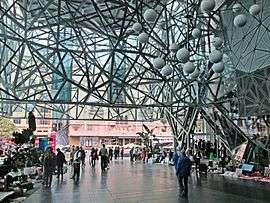 From top: NGV International on St Kilda Road in Southbank, Ian Potter Centre: NGV Australia at Federation Square | |

| |
| Established | 24 May, 1861 |
|---|---|
| Location | Southbank, Melbourne, Australia |
| Coordinates | 37.822595°S 144.968634°E |
| Type | Art museum |
| Visitors | 3,210,000 (2017/18)[1] |
| Director | Tony Ellwood |
| Public transit access | Flinders Street station Tram routes 1, 3, 5, 6, 16, 64, 67, 72 |
| Website | www |
The NGV houses an encyclopedic art collection across two sites: NGV International, located on St Kilda Road in the Melbourne Arts Precinct of Southbank, and the Ian Potter Centre: NGV Australia, located nearby at Federation Square. The NGV International building, designed by Sir Roy Grounds, opened in 1968, and was redeveloped by Mario Bellini before reopening in 2003. It houses the gallery's international art collection and is on the Victorian Heritage Register. Designed by Lab Architecture Studio, the Ian Potter Centre opened in 2002 and houses the gallery's Australian art collection.
History
19th century

In 1850, the Port Phillip District of New South Wales was granted separation, officially becoming the colony of Victoria on 1 July 1851. In the wake of a gold rush the following month, Victoria emerged as Australia's richest colony, and Melbourne, its capital, Australia's largest and wealthiest city. With Melbourne's rapid growth came calls for the establishment of a public art gallery, and in 1859, the Government of Victoria pledged £2000 for the acquisition of plaster casts of sculpture.[2] These works were displayed in the Museum of Art, opened by Governor Sir Henry Barkly in May 1861 on the lower floor of the south wing of the Public Library (now the State Library of Victoria) on Swanston Street.[3] Further money was set aside in the early 1860s for the purchase of original paintings by British and Victorian artists. These works were first displayed in December 1864 in the newly opened Picture Gallery, which remained under the curatorial administration of the Public Library until 1882.[4][5] Grand designs for a building fronting Lonsdale and Swanston streets were drawn by Nicholas Chevalier in 1860 and Frederick Grosse in 1865, featuring an enormous and elaborate library and gallery, but these visions were never realised.

On 24 May 1874, the first purpose built gallery, known as the McArthur Gallery, opened in the McArthur room of the State Library, and the following year, the Museum of Art was renamed the National Gallery of Victoria.[3] The McArthur Gallery was only ever intended as a temporary home until the much grander vision was to be realised.[6] However such an edifice did not eventuate and the complex was instead developed incrementally over several decades.
The National Gallery of Victoria Art School, associated with the gallery, was founded in 1867 and remained the leading centre for academic art training in Australia until about 1910.[7] The School's graduates went on to become some of Australia's most significant artists. This later became the VCA (Victorian College of the Arts), which was bought by The University of Melbourne in 2007 after it went bankrupt.
In 1887, the Buvelot Gallery (later Swinburne Hall) was opened, along with the Painting School studios. In 1892, two more galleries were added: Stawell (now Cowen) and La Trobe.[3]
In 1888, the gallery purchased Lawrence Alma-Tadema's 1871 painting The Vintage Fsstival for £4000, its most expensive acquisition of the 19th-century.
20th century

The gallery's collection was built from both gifts of works of art and monetary donations. The most significant, the Felton Bequest, was established by the will of Alfred Felton and from 1904, has been used to purchase over 15,000 works of art.[9]
Since the Felton Bequest, the gallery had long held plans to build a permanent facility, however it was not until 1943 that the State Government chose a site, Wirth's Park, just south of the Yarra River.[10] £3 million was put forward in February 1960 and Roy Grounds was announced as the architect.[11]
In 1959, the commission to design a new gallery was awarded to the architectural firm Grounds Romberg Boyd. In 1962, Roy Grounds split from his partners Frederick Romberg and Robin Boyd, retained the commission, and designed the gallery at 180 St Kilda Road (now known as NGV International). The new bluestone clad building was completed in December 1967[12] and Victorian premier Henry Bolte officially opened it on 20 August 1968.[13] One of the features of the building is the Leonard French stained glass ceiling, one of the world's largest pieces of suspended stained glass, which casts colourful light on the floor below.[14] The water-wall entrance is another well-known feature of the building.
In 1997, redevelopment of the building was proposed, with Mario Bellini chosen as architect and an estimated project cost of $161.9 million. The design was extensive, creating all new galleries leaving only the exterior, the central courtyard and Great Hall intact.[15] The plans included doing away with the water wall, but following public protests organised by the National Trust Victoria, the design was altered to include a new one slightly forward of the original.[16] During the redevelopment, many works were moved to a temporary external annex known as ‘NGV on Russell’, at the State Library with its entrance on Russell Street.[3]
21st century
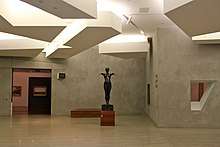
A major fundraising drive was launched on 10 October 2000 to redevelop the ageing St Kilda Road building and although the state government committed the majority of the funds, private donations were sought in addition to federal funding. The drive achieved its aim and secured $15 million from the Ian Potter Foundation on 11 July 2000, $3 million from Lotti Smorgon, $2 million from the Clemenger Foundation, and $1 million each from James Fairfax and the Pratt Foundation.[17]
NGV on Russell closed on 30 June 2002[3] to make way for the staged opening of the new St Kilda Road gallery. It was officially opened by premier Steve Bracks on 4 December 2003.[18]
The Ian Potter Centre: NGV Australia in Federation Square was designed by Lab Architecture Studio to house the NGV's Australian art collection. It opened in 2002. As such, the NGV's collection is now housed in two separate buildings, with Grounds' building renamed NGV International.
NGV Contemporary
In 2018 the State Government of Victoria announced a new contemporary art gallery would built behind the Arts Centre and the existing NGV International building.[19] The Government spent $203 million to begin the project, including $150 million to purchase the former Carlton and United Breweries building for the new gallery, which is planned to include 18,000 square metres of new public space, new space for contemporary art and design exhibitions, and a new home for the Australian Performing Arts Gallery.[19][20]
Collection
Asian art

The NGV's Asian art collection began in 1862, one year after the gallery's founding, when Frederick Dalgety donated two Chinese plates. The Asian collection has since grown to include significant works from across the continent.
Australian art
The NGV's Australian art collection encompasses Indigenous (Australian Aboriginal) art and artefacts, Australian colonial art, Australian Impressionist art, 20th century, modern and contemporary art.
The 1880s saw the birth and development of the Heidelberg School (also known as Australian Impressionism) in the outer suburbs of Melbourne, and the NGV was well-placed to acquire some of the movement's key artworks, including Tom Roberts' Shearing the Rams (1890), Arthur Streeton's ‘The purple noon's transparent might’ (1896), and Frederick McCubbin's The Pioneer (1904).[21]
The Australian collection includes works by Charles Blackman, Arthur Boyd, John Brack, Rupert Bunny, Louis Buvelot, Nicholas Chevalier, Charles Conder, David Davies, William Dobell, Russell Drysdale, E. Phillips Fox, John Glover, Eugene von Guerard, Hans Heysen, George W. Lambert, Sydney Long, John Longstaff, Frederick McCubbin, Sidney Nolan, John Perceval, Margaret Preston, Hugh Ramsay, Tom Roberts, John Russell, Grace Cossington Smith, Arthur Streeton, Fred Williams and others.
A large number of works were donated by Dr. Joseph Brown in 2004 which form the Joseph Brown Collection.
Selected works
 Aboriginal shields
Aboriginal shields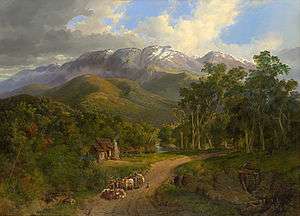 The Buffalo Ranges (1864) by Nicholas Chevalier, the first painting of an Australian subject to be acquired by the gallery
The Buffalo Ranges (1864) by Nicholas Chevalier, the first painting of an Australian subject to be acquired by the gallery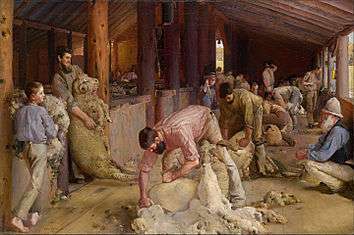 Tom Roberts, Shearing the Rams, 1890
Tom Roberts, Shearing the Rams, 1890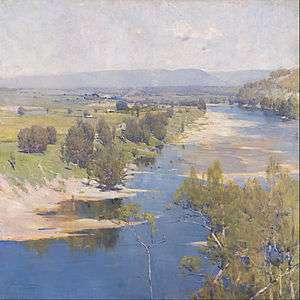
International art
The NGV's international art collection encompasses European and international paintings, fashion and textiles, photography, prints and drawings, Asian art, decorative arts, Mesoamerican art, Pacific art, sculpture, antiquities and global contemporary art. It has strong collections in areas as diverse as old masters, Greek vases, Egyptian artefacts and historical European ceramics, and contains the largest and most comprehensive range of artworks in Australia.[22]
The international collection includes works by Bernini, Bordone, Canaletto, Cézanne, Constable, Correggio, Dali, Degas, van Dyck, Gainsborough, Gentileschi, El Greco, Manet, Memling, Modigliani, Monet, Picasso, Pissarro, Pittoni, Poussin, Rembrandt, Renoir, Ribera, Rothko, Rubens, Tiepolo, Tintoretto, Turner, Uccello, Veronese and others.
One of the highlights of the NGV's international collection is Auguste Rodin's first cast of his iconic sculpture The Thinker, executed in 1884.[23] The NGV is also home to the only portrait of Lucrezia Borgia known to have been painted from life, dated to approximately 1515 and attributed to Dosso Dossi.[24]
Selected works
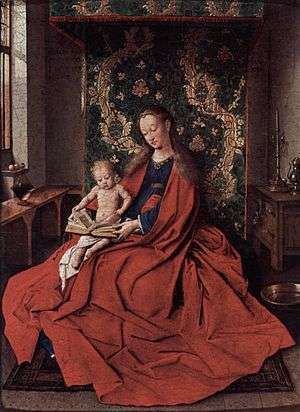
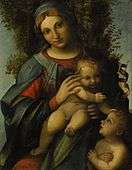 Correggio, Madonna and Child with infant St John the Baptist, 1514–15
Correggio, Madonna and Child with infant St John the Baptist, 1514–15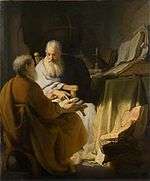 Rembrandt, Two old men disputing, 1628
Rembrandt, Two old men disputing, 1628
 Anthony van Dyck, Rachel de Ruvigny, Countess of Southampton, 1640
Anthony van Dyck, Rachel de Ruvigny, Countess of Southampton, 1640 George Stubbs, A Lion Attacking a Horse, 1765
George Stubbs, A Lion Attacking a Horse, 1765 Thomas Gainsborough, Richard St George Mansergh-St George, 1776
Thomas Gainsborough, Richard St George Mansergh-St George, 1776 J. M. W. Turner, The Red Rigi, 1842
J. M. W. Turner, The Red Rigi, 1842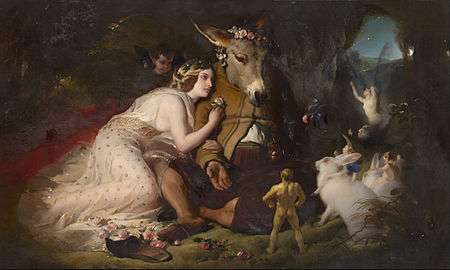
 John Everett Millais, The Rescue, 1855
John Everett Millais, The Rescue, 1855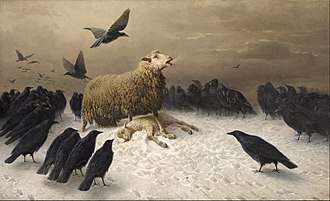 August Friedrich Schenck, Anguish, 1878
August Friedrich Schenck, Anguish, 1878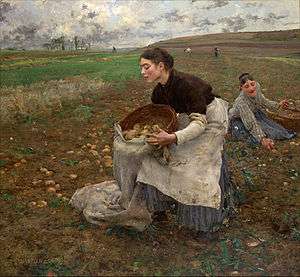 Jules Bastien-Lepage, October, 1878
Jules Bastien-Lepage, October, 1878.jpg) Claude Monet, Vétheuil, 1879
Claude Monet, Vétheuil, 1879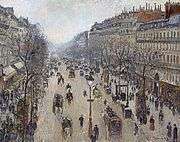 Camille Pissarro, Boulevard Montmartre, morning, cloudy weather, 1897
Camille Pissarro, Boulevard Montmartre, morning, cloudy weather, 1897 Pierre Bonnard, Siesta, 1900
Pierre Bonnard, Siesta, 1900- Amedeo Modigliani, Portrait of the painter Manuel Humbert, 1916
Photography

In 1967, the NGV established the first curatorial department dedicated to photography in an Australian public gallery,[25] one of the first in the world. It now holds over 15,000 works. In that same year, the Gallery acquired the photography collection's first work, Surrey Hills street 1948 by David Moore and in 1969 the first international work was acquired, Nude 1939 by František Drtikol. The first photographer to exhibit solo at the NGV was Mark Strizic in 1968.[26][27] Jennie Boddington, a filmmaker, was appointed first full-time curator of photography in 1972, possibly only the third such appointment amongst world public institutions.[28][29]
Prints and drawings

The NGV's Department of Prints and Drawings is responsible for one third of the gallery's collection. Highlights among the department's holdings include one of the world's largest collections of engravings and woodcuts by Dürer.[30] The NGV is also said to have one of the most impressive collections of works by William Blake, including 36 of the 102 watercolours he worked on up until his death in 1827 to illustrate the Divine Comedy by Dante, the largest number of works from this series held by any gallery in the world.[31][32] Rembrandt and Goya are also well-represented, and the Australian collection contains a detailed account of the history of graphic arts in Australia.[33]
The NGV no longer dedicates a space to exhibiting works from the Prints and Drawings collection, though some works on paper are rotated within the permanent collection galleries and may appear in exhibitions.[33] Works in the collection may be viewed by appointment in the department's Print Study Room.[33]
Controversies
As a "National Gallery"
When plans for the construction of the National Gallery of Australia in Canberra became firmly established in the 1960s, Australia's state galleries removed the word "national" from their names (for example, the National Gallery of New South Wales in Sydney became the Art Gallery of New South Wales). This naming convention dated back to the 19th century when Australia's colonies were self-governing political entities and had yet to federate. Only the NGV has retained "national" in its name.[34] This has proven to be somewhat contentious, given that the NGV is technically not a national gallery, and occasionally there have been calls for it to follow the example of the other state galleries. According to former Victorian Premier Steve Bracks, "We won't be renaming the National Gallery of Victoria. It has a great tradition. It is the biggest and best gallery in the country and it's one of the biggest and best in the world."
Picasso theft
A famous event in the museum's history occurred in 1986 with the theft of Pablo Picasso's painting The Weeping Woman (1936). A person or group identifying themselves as the "Australian Cultural Terrorists" claimed responsibility for the theft, stating that the painting was stolen in protest against the perceived poor treatment of the arts by the state government of the time. They sought as a ransom the establishment of an art prize for young artists. The painting was found undamaged in a railway locker two weeks later and returned to the gallery.[35]
Special exhibitions
An exhibition known as "The Field" opened the gallery's new premises on St Kilda Road in 1968. Reflecting the influence of abstract art, particularly New York-inspired Color Field painting, it featured 74 works by forty (mostly emerging young) Australian painters and sculptors. Described as a radical departure from the gallery's more traditional program, it signified more broadly a growing internationalisation of the Australian art world. The NGV held an exhibition titled "The Field Revisited" in 2018 to mark its 50th anniversary.[36]
Melbourne Winter Masterpieces
The NGV has held several large exhibitions known as Melbourne Winter Masterpieces exhibitions, starting with Impressionists: Masterpieces from the Musee d'Orsay in 2004.
| Year | Duration | Exhibition Title | Attendance[37] | Notable works and information |
|---|---|---|---|---|
| 2004 | 17 June - 26 September | Impressionists: Masterpieces from the Musée d'Orsay | 371,000 | An additional exhibition of Caravaggio paintings was also held in 2004 |
| 2005 | 24 June - 2 October | Dutch Masters from the Rijksmuseum, Amsterdam | 219,000 | Vermeer's painting The Love Letter was exhibited, the first time a Vermeer painting had been exhibited in Australia |
| 2006 | 30 June - 8 October | Picasso: Love and War 1935–1945 | 224,000 | Over 300 Picasso drawings and paintings from 1935–1945, curated by Anne Baldassari, Director of the Musée Picasso, Paris[38] |
| 2007 | 30 June - 7 October | Guggenheim Collection 1940s to now | 180,000 | More than 85 works by 68 artists, mainly from the Solomon R. Guggenheim Museum, New York City, but also from other Guggenheim Museums in Venice, Bilbao, and Berlin. The exhibition did not travel to any other city[39][40] |
| 2008 | 28 June - 5 October | Art Deco 1910—1939 | 241,000 | Organised by the Victoria and Albert Museum, London[41] |
| 2009 | 13 June - 4 October | Salvador Dalí Liquid Desire | 333,000 | |
| 2010 | 19 June - 10 October | European Masters: Städel Museum, 19th–20th Century | 200,000 | |
| 2011 | 13 June - 4 October | Vienna Art and Design | 172,000 | |
| 2012 | 2 June - 7 October | Napoleon: Revolution to Empire | 189,000 | |
| 2013 | 10 May - 8 September | Monet's Garden: The Musée Marmottan Monet, Paris | 342,000 | |
| 2014 | 16 May - 31 August | Italian Masterpieces from Spain's Royal Court, Museo del Prado | 153,000 | |
| 2015 | 31 July - 8 November | Masterpieces from the Hermitage: The Legacy of Catherine the Great | 172,000 | Exhibition featured pieces by Rembrandt, Rubens, Velazquez, Van Dyck and others |
| 2016 | 24 June - 18 September | Degas: A New Vision | 197,500 | |
| 2017 | 28 April - 12 July | Van Gogh and the Seasons | 462,262 | Exhibition recorded a total attendance figure of 462,262, making it the most popular ticketed art exhibition ever presented in Victoria,[42] and the most successful ticketed exhibition in the gallery's 156-year history.[43][44] The exhibition is credited for generating almost $56 million for the Victorian economy.[45] |
| 2018 | 9 June - 7 October | MoMA: 130 Years of Modern and Contemporary Art | 404,034 | Exhibition in partnership with the Museum of Modern Art in New York City. Includes over 200 key works arranged into eight chronological and thematic sections.
The exhibition concluded with a total attendance figure, of 404,034, making it the NGV’s second most attended ticketed exhibition on record.[46] |
| 2019 | 24 May - 13 October | Terracotta Warriors and Cai Guo-Qiang | The exhibition included a large-scale presentation of the China's First Emperor's terracotta warriors presented alongside an exhibition of new, commissioned works by Chinese contemporary artist Cai Guo-Qiang.[47][48][49] The exhibition include 150 historical Chinese artefacts, eight terracotta warriors, two full-sized horses and two replica bronze chariots of Zhou, Qin, Han dynasties, which were lent by Shaanxi History Museum in Xi'an and many other Chinese institutes.[50] |
NGV Triennial
In 2013 the NGV launched "Melbourne Now", an exhibition which celebrated the latest art, architecture, design, performance and cultural practice to reflect the complex cultural landscape of creative Melbourne. "Melbourne Now" ran from 22 November 2013 – 23 March 2014 and attracted record attendances of 753,071.[51] Following the success of "Melbourne Now", in 2–14 March the NGV announced a major new initiative, the NGV Triennial. Beginning in the Summer of 2017 and to be held every three years, this ambitious event will be a large-scale celebration of the best of contemporary international art and design.[52] The inaugural Triennial ran from 15 December 2017 to 15 April 2018, and drew almost 1.3 million visitors during its run, making it the most attended exhibition in the gallery's history.[53][54][55]
Directors of the NGV
Directors of the NGV since its inception:[56]
- G. F. Folingsby, 1882–91
- Lindsay Bernard Hall, 1892–35[57]
- William Beckwith McInnes, (acting) 1935–36
- P. M. Carew-Smyth, (acting) 1937
- J. S. Macdonald, 1936–41
- Sir Ernest Daryl Lindsay, 1942–55
- Eric Westbrook, 1956–73
- Gordon Thomson, 1973–74
- Eric Rowlison, 1975–80
- Patrick McCaughey, 1981–87
- T. L. Rodney Wilson, 1988
- James Mollison, AO, 1989–95
- Timothy Potts, 1995–98
- Gerard Vaughan, 1999–2012
- Tony Ellwood, 2012–present[58]
References
- National Gallery of Victoria (2018). "NGV Annual Report 2017/18" (PDF).
- Mansfield, Elizabeth. Art History and Its Institutions: Foundations of a Discipline. Psychology Press, 2002. p. 105
- [The History of the State Library of Victoria http://guides.slv.vic.gov.au/slvhistory/museumgallerypro]
- Lane, Terence. Nineteenth-century Australian Art in the National Gallery of Victoria. National Gallery of Victoria, 2003. pp. 13–14.
- McCulloch, Alan. The Encyclopedia of Australian Art. University of Hawaii Press, 1994. p. 815
- State Library of Victoria Complex. 328 Swanston Street, Melbourne Conservation Management Plan. Lovell Chen
- McCulloch, Alan; Susan McCulloch (1994). The Encyclopedia of Australian Art. Allen & Unwin. p. 864 (Appendix 8). ISBN 1-86373-315-9.
- Shmith, Michael. "Raising the roof with a glass ceiling", The Age. Retrieved 2 December 2012.
- "NGV Media | Welcome to NGV Media". ngv.vic.gov.au. Retrieved 15 August 2013.
- National Gallery of Victoria - Victorian Heritage Register
- "Democratic" Art Gallery Planned. The Canberra Times. Sat 27 Feb 1960
- Green, Louise McO. "NGV Women's Association History". National Gallery of Victoria. Archived from the original on 30 August 2007. Retrieved 22 December 2007.
- The Canberra Times. Wed 21 Aug 1968. pg 3
- Stephens, Andrew (17 August 2018). "Is this Melbourne's favourite ceiling? 50 years on, we're still looking up at NGV". The Sydney Morning Herald. Retrieved 2 August 2019.
- "The National Gallery of Victoria (NGV) Redevelopment". Retrieved 26 February 2018.
- "Waterwall at Melbourne's NGV". The Sydney Morning Herald. Retrieved 24 October 2019.
- National Gallery of Victoria Annual Report 2000-2001 http://www.ngv.vic.gov.au/wp-content/uploads/2014/09/ngv_corp_annualreport_2000_01.pdf
- National Gallery of Victoria Annual Report 2003-2004 http://www.ngv.vic.gov.au/wp-content/uploads/2014/09/ngv_corp_annualreport_2003_04.pdf
- Andie Noonan (3 June 2018). "Art lovers rejoice — Melbourne to get new contemporary art gallery". ABC News. Retrieved 2 August 2019.
- Hinchliffe, Joe (2 June 2018). "'Game-changer': Melbourne to build nation's largest contemporary art gallery". The Age. Retrieved 2 August 2019.
- Galbally, Ann. The Collections of the National Gallery of Victoria. Oxford University Press, 1987. ISBN 9780195545913, p. 36.
- "Collection Online > collections > Collection Areas". ngv.vic.gov.au. 31 July 2013. Archived from the original on 4 August 2013. Retrieved 15 August 2013.
- Blanchetière, François; Thurrowgood, David (2013). "Two Insights Into Augustus Rodin's The Thinker". Art Journal. National Gallery of Victoria. 52.
- "NGV Solves Mystery of Renaissance Portrait" (26 November 2008), NGV. Retrieved 4 June 2020.
- Although the Art Gallery of South Australia began collecting photographs as fine art in 1922, it houses them with 'Australian Prints, Drawings and Photographs'(see: http://www.artgallery.sa.gov.au/agsa/home/Collection/australlian_prints_drawings_and_photographs.html). Other Photography collections in public galleries are: The Art Gallery of New South Wales, est.1975 (see: http://www.artgallery.nsw.gov.au/collection/photography/); Queensland Art Gallery | Gallery of Modern Art (QAGOMA) started their collection in 1987 where works are housed as art of the Contemporary Australian Art collection
- Mark Strizic: A Journey in Photography information National Portrait Gallery Travelling Exhibitions site http://www.portrait.gov.au/site/exhibition_subsite_strizic4.php Archived 28 September 2013 at the Wayback Machine
- Coslovich, Gabriella (19 October 2011). "Times a-changin' caught on camera". The Age. Retrieved 6 January 2020.
- Ely, Deborah History of Photography, 01 June 1999, Vol.23(2), p.118-122
- Cox, Leonard B. The National Gallery of Victoria, 1861-1968: The Search for a Collection. Melbourne: The National Gallery of Victoria; Brown Prior Anderson Pty Ltd, 1971
- Zdanowicz, Irena. Albrecht Dürer in the Collection of the National Gallery of Victoria. National Gallery of Victoria, 1994. ISBN 9780724101696.
- "NGV to showcase its William Blake collection" Archived 8 April 2018 at the Wayback Machine (25 March 2014), Arts Review. Retrieved 8 April 2018.
- Harford, Sonia (4 April 2014). "The resurrection of William Blake's illustrations on Dante's Divine Comedy". The Age. Retrieved 6 January 2020.
- "Prints & Drawings | NGV". www.ngv.vic.gov.au. Retrieved 6 January 2020.
- Knell, Simon. National Galleries. Routledge, 2016. ISBN 9781317432425, p. 104.
- Justin Murphy; Susan Cram (19 September 2004). "Stolen Picasso". Rewind (ABC TV). Australian Broadcasting Corporation. Archived from the original on 30 July 2012. Retrieved 10 September 2010.
- "NGV to Restage 1968's Groundbreaking Exhibition 'The Field'", Daily Review (14 March 2018). Retrieved 17 April 2018.
- Creative Victoria. "Melbourne Winter Masterpieces". creative.vic.gov.au. Archived from the original on 8 July 2018. Retrieved 8 July 2018.
- "Arts Victoria – Melbourne Winter Masterpieces".
- "Guggenheim Collection: 1940s to Now". NGV. 2007. Archived from the original on 27 September 2007. Retrieved 10 October 2007.
- "Guggenheim leaves Melbourne". Entertainment Depot, Australia. 8 October 2007. Archived from the original on 31 July 2008. Retrieved 10 October 2007.
- "Art Deco". NGV. 2008. Archived from the original on 14 June 2009. Retrieved 10 June 2009.
- "Record-Busting Van Gogh Draws Over 110,000 Tourists To Victoria". Retrieved 1 August 2017.
- Cunningham, Melissa. "Starry final night for Van Gogh and the Seasons at National Gallery of Victoria". The Age. Fairfax Media. Retrieved 15 July 2017.
- "Van Gogh works draw record crowds to NGV". 9 News. Archived from the original on 10 July 2017. Retrieved 15 July 2017.
- "Melbourne Winter Masterpieces". Creative Victoria. Government of Victoria. Archived from the original on 17 July 2017. Retrieved 15 July 2017.
- "More than 400,000 visit MoMA at NGV" (PDF). National Gallery of Victoria. Retrieved 31 January 2019.
- "Terracotta Warriors & Cai Guo-Qiang | NGV". www.ngv.vic.gov.au. Retrieved 2 August 2019.
- Francis, Hannah (17 December 2018). "Terracotta warriors march towards Melbourne with a bang". The Sydney Morning Herald. Retrieved 2 August 2019.
- Jefferson, arts editor Dee (25 May 2019). "Beyond terracotta warriors: Artist provides antidote to simplistic, 'exoticised' idea of China". ABC News. Retrieved 2 August 2019.
- "Terracotta Warriors & Cai Guo-Qiang | NGV". www.ngv.vic.gov.au. Retrieved 2 August 2019.
- "NGV Media". NGV. 2014. Retrieved 23 April 2014.
- "NGV Media". NGV. 2014. Retrieved 23 April 2014.
- Neutze, Ben. "The NGV's Triennial is the gallery's most-visited exhibition ever". TimeOut. Archived from the original on 11 June 2019. Retrieved 3 June 2018.
- Plant, Simon. "NGV Triennial exhibition reaches record 1 million visitors". news.com.au. News Corp. Retrieved 3 June 2018.
- Noonan, Andie. "Melbourne to build largest contemporary art gallery in Australia". Australian Broadcasting Corporation. Retrieved 3 June 2018.
- Alan McCulloch, Susan McCulloch and Emily McCulloch Childs, The New McCulloch's Encyclopedia of Australian Art (4th edition), Aus Art Editions & Miegunyah Press, 2006, p. 458.
- Ann E. Galbally, 'Hall, Lindsay Bernard (1859 - 1935) Archived 12 June 2011 at the Wayback Machine', Australian Dictionary of Biography, Volume 9, MUP, 1983, pp 164–165. Retrieved 6 april 2020.
- "Tony Ellwood, Director of the National Gallery of Victoria | NGV". www.ngv.vic.gov.au. Retrieved 1 October 2017.
External links
| Wikimedia Commons has media related to National Gallery of Victoria. |
